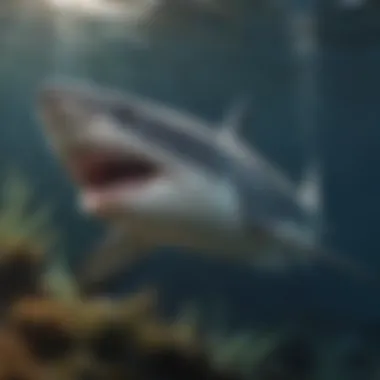Exploring the Potential for Sharks in the Great Lakes


Intro
The Great Lakes, often dubbed the largest group of freshwater lakes in the world, have long captivated the imagination of scientists and adventurers alike. Situated in the heart of North America, these sprawling bodies of water teem with a rich array of wildlife from minnows to massive sturgeon. But what if I told you there has been chatter—speculation, even—about sharks swimming beneath the surface of these lakes? Yes, sharks. This article aims to peel back the layers of this unusual claim. Through an exploration of historical narratives, scientific analysis, and ecological considerations, we're diving deep into a topic that straddles the line between myth and reality.
As we navigate through this narrative, we will uncover the common names and scientific classification of sharks that could theoretically inhabit these waters, assess their physical characteristics, and discuss their habitat preferences. A closer look at their behavior and social dynamics will also be included, ensuring we paint a detailed picture of these impressive creatures. Finally, we will evaluate their conservation status, discussing current population trends, threats, and the efforts in place to ensure their survival.
Not just an academic exercise, this article holds real relevance for varying audiences, from veterinarians and wildlife biologists to families interested in wildlife studies. The discussion around shark presence in the Great Lakes opens up a window into broader ecological impacts and conservation challenges, an inquiry that is more relevant now than ever.
Let's set sail on this intellectual journey, where myth meets marine biology, and explore the unexpected possibility of sharks in the Great Lakes.
Intro to Sharks in Freshwater
The exploration of sharks in freshwater ecosystems, particularly in settings like the Great Lakes, raises more questions than answers. While marine sharks are often seen as fearsome predators of the ocean, their potential existence in freshwater environments complicates our understanding of their adaptability and ecological roles. The significance of this topic is multi-fold, as it not only challenges traditional views of marine biology but also provokes necessary conversations about aquatic conservation, biodiversity, and environmental health.
Understanding Sharks and Their Habitats
Sharks are usually associated with salty water. They thrive in oceans, exhibiting various adaptations that make them well-suited to marine life. However, recent studies have hinted at the surprising possibility of certain sharks making their home in freshwater environments. This possibility calls for an understanding of how sharks adapt their biological make-up to survive in different aquatic settings.
Sharks are equipped with unique physiological features, such as a specialized system for dealing with osmotic pressure, which generally prevents them from thriving in freshwater due to lower salinity levels. Yet, instances of bull sharks have been documented traveling up rivers, suggesting a remarkable ability to adjust. The existence of these adaptable species leads to fascinating inquiries into the biological nuances that allow some shark species to challenge conventional habitat parameters.
The Great Lakes: An Overview
The Great Lakes, comprised of Superior, Michigan, Huron, Erie, and Ontario, are the largest group of freshwater lakes in the world by total area. Stretching over 94,000 square miles, this system hosts a diversity of ecosystems and marine life. With depths reaching over 1,300 feet and vast surface areas, the Great Lakes offer a multitude of habitats that could indeed provide a sanctuary for shark species, given the right ecological conditions.
However, the unique environmental factors of the Great Lakes—such as varying temperatures, seasonal ice cover, and distinct water chemistry—place limitations on which species can survive. Understanding the Great Lakes as an ecosystem is crucial because it sets the stage for investigating potential shark inhabitants. Each lake has its own microclimate, influencing local fauna.
While the idea of sharks inhabiting freshwater lakes remains often ridiculed, the truth is that nature has its ways of surprising us, and adaptations can blur the lines between marine and freshwater environments.
Historical Accounts and Myths
The exploration of sharks in the Great Lakes leads us into a web of historical accounts and myths that have shaped public perception over the years. Understanding these narratives is vital in appreciating how folklore and storytelling have influenced our views on the natural world. Myths about creatures lurking in the deep waters capture imaginations, giving rise to legends that, while often exaggerated, play a role in our fascination with aquatic life. These stories offer not only entertainment but also insights into the human psyche and how we relate to nature.
Legends of Lake Monsters
In every corner of the world, there are tales of lake monsters—beasts that dwell in depths unknown, inspiring both curiosity and fear. The Great Lakes are no exception. Local legends recount sightings of creatures resembling massive serpents or prehistoric beasts gracefully navigating the vast stretches of water.
One particular legend is that of "Nessie,” a creature believed to haunt Lake Ontario. Sightings have been reported for generations, with descriptions varying from that of a giant fish to a long-necked beast akin to the famed Loch Ness Monster in Scotland. While many dismiss such tales as mere superstition, they reveal a deeper truth about human connection to the environment. People often fill the gaps of scientific understanding with fantasies that allow them to cope with the vastness of nature.
Such legends, however, can have consequences. For instance, they may lead people to take unnecessary precautions or foster irrational fear about swimming in certain areas. While these stories are fascinating, they also distort the real risks associated with aquatic activities and the true nature of the ecosystems in the Great Lakes.
Media Influence on Public Perception
The media's role in shaping public perception of sharks and other aquatic threats cannot be overstated. Documentaries, news reports, and even fictional portrayals often focus on the sensational aspects of marine life, leading to misconceptions. Sharks, in particular, are frequently cast as fearsome predators, their portrayal driven more by dramatic storytelling than by scientific fact.
A notorious case involved the release of a television special that claimed sightings of shark-like creatures in Lake Michigan, amplifying fears and leading to widespread concern among local residents. The sensationalized media coverage turned a speculative sighting into a regional panic, illustrating how quickly misinformation can spread and shape public sentiment.


This phenomenon is exacerbated by social media platforms where rumitung begets hysteria within moments. As people share stories online, it becomes a digital game of telephone—each retelling altering the original accounts and sometimes straying further from reality.
"We have to be cautious, for every sensational story has its roots in a grain of truth, while also being twisted by imagination and exaggeration."
Understanding these dynamics is essential for accurate education regarding sharks in freshwater ecosystems. It highlights the importance of responsible media reporting and proactive public educational campaigns aimed at clarifying myths versus science. By fostering a more nuanced understanding of our aquatic environments, we can appreciate them without fear and respect the genuine ecological interplay that exists.
Biological Aspects of Sharks
The study of sharks in the Great Lakes isn't just about the mere presence of these formidable creatures; it's essential to understand their biological capacities, implications for the local ecosystem, and how they adapt to life in freshwater environments. The biological aspects illuminate not just who these sharks are but how they can coexist with the native species of the Great Lakes.
Species that Thrive in Freshwater
Contrary to popular belief, not all sharks are ocean dwellers confined to saltwater. Some species have shown a remarkable ability to adapt to freshwater habitats. In the Great Lakes, the potential presence of sharks such as the bull shark is of significant interest. The bull shark can tolerate both salt and freshwater, which makes it a notable contender. It's not just about survival either; studies have shown that bull sharks have been found hundreds of miles up rivers connected to the ocean, showcasing their mobility.
Other species, like the river shark, naturally inhabit brackish waters and have also been reported in rivers and estuaries. However, instances of these species in the Great Lakes require rigorous scientific investigation. Understanding their biology isn't merely an academic endeavor but holds implications for local ecosystems as well. If such sharks can establish a foothold in these waters, they could drastically alter the existing food chain and impact local prey populations.
Physiological Adaptations
Sharks are marvels of evolution, possessing unique physiological traits that enable them to thrive in different environments. When we talk about adaptation, we refer to various aspects of their biology that prepare them for life not just in saltwater but in potentially freshwater locales as well.
One of the most crucial adaptations involves osmoregulation. Sharks have developed specialized kidneys that enable them to maintain water and salt balance. This is particularly vital for species adaptating from ocean to freshwater. In simpler terms, it means they are able to excrete excess salt or retain water as necessary, depending on their environment. This ability significantly increases their chances of survival if they venture into lakes.
Moreover, sharks are equipped with a flexible cartilage-based structure instead of bones, which aids buoyancy—an essential factor for swimming in varying densities of water. Some species possess a certain sensory organ known as the ampullae of Lorenzini, which allows them to detect electromagnetic fields produced by other organisms, providing an advantage in murkier freshwater environments.
Understanding how sharks adapt to different water types allows researchers to forecast their potential behaviors should they enter the Great Lakes more prominently.
"The ability of some sharks to adapt physiologically to freshwater environments could change our understanding of these animals in ways we've yet to fully explore."
Environmental Factors in the Great Lakes
Environmental factors play a crucial role in determining the health and viability of any ecosystem, and the Great Lakes are no exception. In this unique freshwater environment, several elements influence marine life, including potential shark inhabitants. Understanding these factors offers insight into how species adapt and thrive in conditions that can be vastly different from ocean habitats.
Water Quality and Ecosystem Balance
Water quality is always at the forefront of ecological discussions. Without clean water, even the most majestic creatures struggle to survive. The Great Lakes face numerous challenges, such as pollution from agricultural runoff, industrial waste, and urban development. These stressors can lead to eutrophication, resulting in algal blooms that deplete oxygen levels and create dead zones. For sharks, who need a healthy ecosystem to anchor their feeding habits and reproduction, poor water quality could be a dealbreaker.
The balance of the ecosystem is intimately tied to water quality. Life forms that make up the food web, from tiny plankton to the larger fish, depend on the clarity and purity of the water. When pollutants enter the water, they can disrupt reproductive cycles and even kill off essential species, disturbing the entire chain. If sharks were to find a home here, they would need a balanced environment rich in prey and low in toxins.
"Pollution isn’t just a problem for fish; it changes the very fabric of the ecosystem, affecting everything from the smallest microbe to apex predators like sharks."
Temperature and Its Effects on Marine Life
Temperature variability is another critical factor affecting all life in the Great Lakes. With climate change altering weather patterns, the temperature of these waters is undergoing shifts that could affect existing species profoundly. Sharks, primarily accustomed to warmer waters, may face challenges in adapting to the cooler temperatures found in these freshwater lakes.
The annual fluctuation in temperature can lead to shifts in species distribution. As the lakes warm in the summer, certain species may thrive, while others suffer. For instance, if temperatures rise, it could create favorable conditions for certain shark species to venture into the Great Lakes. But it’s not just about warmth; temperature also influences breeding cycles and migratory patterns.


Moreover, seasonal changes lead to stratification in the water, affecting oxygen distribution and limiting the areas that are hospitable for various marine life. Sharks may need to adjust their hunting behaviors and habitats depending on these shifts. When studying potential shark populations, understanding how temperature impacts these creatures is paramount in predicting whether they could establish a presence within this unique ecosystem.
Current Research and Findings
Recent years have seen a surge of interest in the possibility of sharks inhabiting the Great Lakes. This focus on research emerges from a blend of curiosity and necessity. As ecosystems evolve, understanding the interdependent relationships within them becomes crucial. Scientific inquiry, therefore, plays a pivotal role in unwrapping how species traditionally at home in saltwater might adapt to a freshwater environment.
Studies of Marine Species in Freshwater
Research conducted on marine species, particularly on those that might migrate to freshwater bodies, suggests surprising adaptability. Shark species like the bull shark and the river shark, for instance, exhibit unique physiological traits which allow their survival in varying salinity levels. Recent studies are shedding light on their prevalence in locations far from the sea.
- Physiological Traits: Some species can handle the transition between salt and freshwater due to specialized osmoregulatory mechanisms. These adaptations challenge long-held assumptions about sharks' habitat preferences.
- Recent Discoveries: Aquatic biologists have recorded sightings of juvenile bull sharks in the St. Lawrence River, thereby expanding their learned behavior and feeding habits into unfamiliar territory.
This burgeoning research not only broadens our understanding of these species but pushes us to reconsider the Great Lakes' capacity to host more marine life than previously thought.
Tracking and Monitoring Marine Life
Keeping an eye on fluctuating populations is central to understanding marine life in freshwater systems. The use of advanced tracking technologies has taken a front seat in this. Scientists are discovering innovative ways to monitor movement and behaviors of species, enabling a clearer picture of ecological impacts.
"The application of telemetry provides invaluable data on the migration patterns and adaptability of species in the Great Lakes."
- Telemetry Techniques: Devices are being deployed to track sharks, allowing researchers to gather real-time data on their movements. These findings reveal patterns related to feeding, breeding, and habitat preferences.
- Ecological Implications: Tracking helps in understanding how these marine species interact with their environment. An influx of saltwater species could lead to unforeseen ecological shifts, potentially disrupting the balance of native fish populations.
The outcome of these studies contributes not only to academic knowledge but also informs conservation strategies. Knowledge gained through monitoring enhances the community’s understanding — leading to more informed decisions regarding human impact and environmental stewardship in the Great Lakes.
By embracing current research, we can continue to unravel the mysteries of sharks in freshwater systems and ensure a healthier ecosystem for future generations.
Conservation Issues and Challenges
The Great Lakes, known for their vast freshwater ecosystems, are home to a variety of species, including those not typically found in freshwater like sharks. However, this intriguing possibility presents a host of conservation issues and challenges that must be considered carefully. Understanding these challenges is crucial not just to marine biologists and ecologists, but also to the general public who use and enjoy these precious resources.
The importance of addressing conservation challenges cannot be overstated. Sharks, if they do make their way into the Great Lakes, could fundamentally alter the existing ecological balance. They are apex predators, which means their presence—or absence—affects many other species in the ecosystem. In this section, we will explore the primary threats to native species, the impact of human activity on their habitats, and the steps necessary for responsible environmental stewardship.
Threats to Native Species
The introduction or migration of sharks into the Great Lakes could introduce a myriad of threats to native fish populations. For instance, consider the case of the Great Lakes' native species such as the lake trout or whitefish. Sharks could potentially prey on these fish, leading to a sharp decline in their populations.
"The balance of any ecosystem hinges on its food web; sharks could tip that scale in unexpected ways."
Some challenges posed by shark presence may include:
- Increased Competition for Resources: Sharks may compete with native species for food and habitat, which could lead to overpopulation of some species while depleting others.
- Changes in Behavioral Patterns: The introduction of a new predator can force native fish to alter their habitats and behaviors, potentially leading to stress and increased mortality rates.
- Disease Transference: Sharks can carry parasites and diseases that, while not harmful to them, could be detrimental to freshwater species. This could put additional stress on an already fragile system.
Human Impact and Environmental Responsibility
Man's longstanding influence on the Great Lakes ecosystem cannot be ignored when discussing conservation. Urban development, pollution, and climate change have all left their mark. The challenges faced by sharks, should they inhabit this ecosystem, are inextricably linked to human activities.


Key areas for consideration include:
- Pollution: Contaminants from urban run-off and industrial discharge can harm all aquatic life, including sharks. Decreased water quality affects reproductive success and can lead to population declines.
- Developmental Pressure: Increased residential and commercial developments around the Great Lakes can lead to habitat destruction. These activities often limit the natural spaces available for marine life to thrive.
- Climate Change: With temperatures rising and water levels fluctuating, the ecological landscape of the Great Lakes is changing. These changes could make the region less hospitable for both native species and newcomers like sharks.
To address these significant challenges, it is imperative to engage in proactive environmental responsibility. This includes:
- Restoration Projects: Implementing projects aimed at restoring habitats and improving water quality can benefit all species residing in the Great Lakes.
- Public Education: Raising awareness about the role of all marine life, including sharks, helps foster a sense of shared responsibility towards conservation efforts.
- Policy Revisions: Sustainable policies that limit harmful activities need to be enforced to protect the delicate balance of the Great Lakes ecosystem.
As we map out the future for sharks—and indeed for all species in this unique environment—recognizing these conservation issues is paramount. The interplay of human activity and ecological balance remains a complex challenge that requires ongoing dialogue and collaborative action.
Public Fascination with Sharks
The allure of sharks stretches far beyond their role in the marine ecosystem. There’s something magnetic about these creatures that captivates the human imagination. Within the context of the Great Lakes, this fascination takes on a unique flavor, fueled by the convergence of history, myth, and modern science. Public interest in sharks can shape perceptions, influence conservation efforts, and enhance educational outreach.
Sharks in Popular Culture
When one thinks of sharks, images from blockbuster films often come to mind. As far as the Great Lakes are concerned, the very idea of these predator fish thriving in freshwater environments has inspired a wide range of media portrayals. Documentaries, novels, and even local folklore often present sharks as menacing threats. Yet, this simplistic view ignores the complexities of ecological interactions.
- Movies and Documentaries: Films like Jaws have cemented the image of sharks as fearsome hunters. This perception can overshadow their ecological importance. Local documentaries exploring the possibility of sharks in the Great Lakes provide a richer narrative of coexistence and biodiversity.
- Social Media Trends: On platforms like Reddit and Facebook, discussions related to sharks spark curiosity. Memes, educational posts, and anecdotal stories create a shared space for fascination and awareness.
The portrayal of sharks in popular culture often steers public perception. Understanding this portrayal is crucial because it affects conservation messaging. Rather than depicting sharks purely as monsters, highlighting their role within the ecosystem can arouse interest in their conservation.
Importance of Education and Awareness
Education plays an essential role in transforming fascination into informed advocacy. Awareness initiatives help clarify misconceptions surrounding sharks, especially in regions where they are not commonly found. In the case of the Great Lakes, where sharks are usually seemingly out of place, the educational efforts must focus on accurate information about their adaptability and ecological significance.
- Community Workshops: Local initiatives, perhaps organized by wildlife biologists or veterinarians, can serve as platforms for knowledge exchange. Through interactive sessions, participants can learn about the ecological balance sharks help maintain and appreciate their role in freshwater systems.
- Engaging Campaigns: Social media campaigns can amplify educational messages, making information accessible and engaging. Stories that highlight recent shark research in the Great Lakes can bridge gaps in understanding, turning public curiosity into actionable knowledge.
"Understanding our ecosystems is vital, and sharks play their part, even in unexpected places like the Great Lakes. Education can transform the public's fear into respect and action."
Public fascination with sharks isn’t trivial; it brings about environmental responsibility. Through informed dialogue and enhanced awareness, it’s possible for communities to forge connections between their local ecosystems and greater environmental stewardship. The unique context of the Great Lakes serves as a crucial point for these conversations. In summary, spotting sharks lurking in freshwater also invites a broader discourse about conservation, biodiversity, and our role within nature.
Finale
The convergence of the realms of sharks and the Great Lakes sets the stage for a rich tapestry of inquiry and fascination. As we step back from the minutiae of our exploration, it's crucial to recognize the vital threads connecting these monumental ecosystems. This article lays bare several key considerations. First, it integrates the historical narratives with scientific evidence, charting the tensions between myth and reality surrounding these powerful creatures. The Great Lakes, while being predominantly freshwater, might offer unexpected corners where these marine animals could flourish.
The Future of Sharks in the Great Lakes
Looking ahead, the future of sharks here hinges on the intricate balance of ecological factors and human interaction. As temperatures warm and climate shifts occur, the adaptability of certain shark species might allow them to infiltrate these freshwater systems.
- Monitoring Emerging Populations: The advancements in underwater technology and the increased acumen in marine biology will be paramount in tracking such movements. Regular monitoring will provide real-time data on shark presence, enabling researchers to respond quickly to any changes in ecosystem dynamics.
- Ecosystem Synergy: Furthermore, a delicate balance must be preserved. The interplay of sharks within the Great Lakes could contribute to healthier fish populations, assuming their presence is maintained responsibly. The introduction of these predatory species could, ironically, restore harmony among the various fish species, mending what might be a faltering ecological balance.
In the face of these potential changes, ongoing research and adaptive management strategies will be crucial for fostering a sustainable future for sharks within the region.
Final Thoughts on Ecological Balance
Ensuring that life persists in equilibrium requires vigilance and a multi-faceted approach. Sharks touch on essential ecological themes, from predator-prey dynamics to habitat preservation. Their experience and roles in the ecosystem echo the need for comprehensive conservation efforts. Here are some crucial takeaways:
- Awareness of Human Impact: The effects of pollution and habitat destruction are rampant in the Great Lakes. Any effort to introduce or sustain shark populations must also focus on elevating the health of the lakes themselves. The implications of invasive species cannot be ignored, as they can upset established relationships within the food web.
- Community Engagement: Strengthening local communities’ understanding and appreciation for these creatures will help mobilize efforts toward conservation. Educational initiatives should extend beyond the classroom, inspiring future generations to take positive action.
- Collaborative Efforts: Conservation groups, local authorities, and scientific communities must forge synergies. Addressing the complex interplay of natural and human-induced challenges will require collective action and sharing of knowledge.
"In the intricate dance of nature, every species, including sharks, plays a role—wielding the power to influence the future of the ecosystem."







